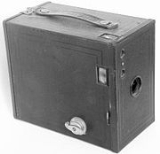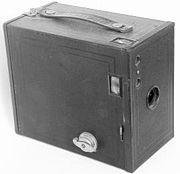
Box camera
Encyclopedia

Camera
A camera is a device that records and stores images. These images may be still photographs or moving images such as videos or movies. The term camera comes from the camera obscura , an early mechanism for projecting images...
in its simplest form. The form of the classic box camera is no more than a cardboard or plastic box with a lens
Photographic lens
A camera lens is an optical lens or assembly of lenses used in conjunction with a camera body and mechanism to make images of objects either on photographic film or on other media capable of storing an image chemically or electronically.While in principle a simple convex lens will suffice, in...
in one end and film
Photographic film
Photographic film is a sheet of plastic coated with an emulsion containing light-sensitive silver halide salts with variable crystal sizes that determine the sensitivity, contrast and resolution of the film...
at the other. A simple box camera has only a single element meniscus
Meniscus
The meniscus is the curve in the upper surface of a liquid close to the surface of the container or another object, caused by surface tension. It can be either convex or concave. A convex meniscus occurs when the molecules have a stronger attraction to each other than to the material of the...
fixed focus lens
Fixed focus lens
A photographic lens for which the focus is not adjustable is called a fixed-focus lens. The focus is set at the time of manufacture, and remains fixed...
and usually lacks control of aperture
Aperture
In optics, an aperture is a hole or an opening through which light travels. More specifically, the aperture of an optical system is the opening that determines the cone angle of a bundle of rays that come to a focus in the image plane. The aperture determines how collimated the admitted rays are,...
and shutter speed
Shutter speed
In photography, shutter speed is a common term used to discuss exposure time, the effective length of time a camera's shutter is open....
s. This makes them suitable for daylight photography of medium distance, static subjects only -- snapshots
Snapshot (photography)
A snapshot is popularly defined as a photograph that is "shot" spontaneously and quickly, most often without artistic or journalistic intent. Snapshots are commonly considered to be technically "imperfect" or amateurish—out of focus or poorly framed or composed...
, essentially. During the type's commercial life span, box cameras with photographic flash, shutter and aperture adjustment were introduced, allowing indoor photos.
Creators/Inventor
The idea of the box camera was created by the French inventor Nicéphore NiépceNicéphore Niépce
Nicéphore Niépce March 7, 1765 – July 5, 1833) was a French inventor, most noted as one of the inventors of photography and a pioneer in the field.He is most noted for producing the world's first known photograph in 1825...
. He was known for his photographic experiments. With the help of Louis Jacques Mandé Daguerre they were able to create the camera to expand the popularity of photography. Soon After Niépce's and Daguerre's new advancements to the box camera many more photographers decided to do their own "photographic experiments" and created their own cameras based on the original box camera. Niépce's created one of the first box cameras during the 1820s.
Beginnings
Box cameras are among the original photographic instruments. Over the decades between the 1720s and 1820s many experiments had been made with the light sensitivity of silver halide crystals, and being able to fix the image without it fading away instantly upon exposure to sunlight.The first permanent photograph using a box camera in 1826 and the exposure lasted all day. Henry Fox Talbot was another pioneer who used box cameras. His early experiments with "mousetrap" cameras are credited with the first photographs on paper.
Purpose
The box camera was commercially produced to expand the popularity of photography. Photography was still a very new idea in the mid-19th century and a product needed to be created to enable the public to participate in this new art. The box camera became the first consumer camera at the end of the 19th century. In 1900, when a Yale plate box camera cost $2 (52.70 in 2009 dollars http://www.measuringworth.com/ppowerus/) and a Kodak rollfilm box only $1 ($26.40 in 2009 dollars http://www.measuringworth.com/ppowerus/) the industry sought new customers for its huge production of these simpler cameras.Typical box cameras
- The Kodak introduced in 1888, the first commercially successful box camera for roll filmRoll filmRollfilm or roll film is any type of spool-wound photographic film protected from white light exposure by a paper backing, as opposed to film which is protected from exposure and wound forward in a cartridge. Confusingly, roll film was originally often referred to as "cartridge" film because of its...
-- the advertising slogan being You press the button – we do the rest. - The Kodak BrownieBrownie (camera)Brownie is the name of a long-running and extremely popular series of simple and inexpensive cameras made by Eastman Kodak. The Brownie popularized low-cost photography and introduced the concept of the snapshot. The first Brownie, introduced in February, 1900, was a very basic cardboard box camera...
, a long lasting series of classical box cameras using roll filmRoll filmRollfilm or roll film is any type of spool-wound photographic film protected from white light exposure by a paper backing, as opposed to film which is protected from exposure and wound forward in a cartridge. Confusingly, roll film was originally often referred to as "cartridge" film because of its...
. - The Ansco pandaAnsco pandaThe Ansco Panda was a simple child's box camera made by the Ansco camera corporation of Binghamton, New York in the 1950s. Its appearance is quite similar to the Kodak Baby Brownie and was designed to compete directly with it. The camera features a black plastic body with cream accents around the...
was designed to compete directly with the Brownies. It used 620 film. - The Kodak InstamaticInstamaticThe Instamatic was a series of inexpensive, easy-to-load 126 and 110 cameras made by Kodak beginning in 1963. The Instamatic was immensely successful, introducing a generation to low-cost photography and spawning numerous imitators....
using 126 film126 film126 is the number given to a cartridge-based film format used in still photography. It was introduced by Kodak in 1963, and is associated mainly with low-end point-and-shoot cameras, particularly Kodak's own Instamatic series of cameras....
, later 110 film110 film110 is a cartridge-based film format used in still photography. It was introduced by Kodak in 1972. 110 is a miniaturised version of Kodak's earlier 126 film format. Each frame is , with one registration hole....
. - The modern disposable cameraDisposable cameraThe disposable or single-use camera is a simple box camera sold with a roll of film installed, meant to be used once. Most use fixed-focus lenses. Some are equipped with an integrated flash unit, and there are even waterproof versions for underwater photography...
using 135 film135 filmThe term 135 was introduced by Kodak in 1934 as a designation for cartridge film wide, specifically for still photography. It quickly grew in popularity, surpassing 120 film by the late 1960s to become the most popular photographic film format...
.
Other box cameras
'Le Phoebus 1870Etienne Carjat (1828–1906) another French photographer created "le Phobus'" around the late 1870s. It was a simple mahogany box camera. It needed no formal shutter. The leather lenscap was removed and replaced for the exposure of light.
Pocket Kodak 1895–1896
Pocket Kodaks were small (2 and 3/16 x 3 x 4 inches) and lightweight (6 ounces), and took roughly 2 inch exposures on 102 size rollfilm. This camera had a new feature, a small view box that told how many exposures of film were left. They were first available in 1895 with either black or red leather covering.
le Papillon 1905–1908
Meaning "the butterfly," le Papillon was a small French stereo camera which made 45mm x 107mm stereoscopic images on glass plates in single plateholders.
No. 00 Cartridge Premo Camera, 1916–1922
The No. 00 Cartridge Premo was Kodak's smallest box camera ever. It was only 2½ inches tall. It uses a simple rotary shutter with meniscus lens, and does not have a viewfinder. The photographer must use the leatherette covering to attempt to see the subject of the photograph.
See also
- A toy cameraToy cameraToy cameras are simple, inexpensive film box cameras made almost entirely out of plastic, often including the lens. The term is misleading, since they are not merely 'toys' but are in fact capable of taking photographs. Many were made to be given away as novelties or prizes...
is a simple, inexpensive box camera that uses film. The body, and sometimes the lens, is made of plastic

